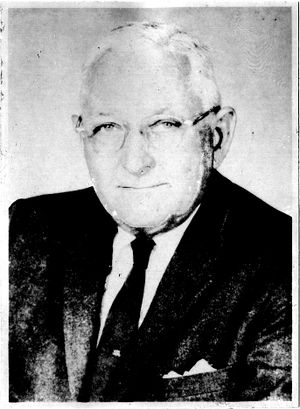Samuel B. Griscom
- Birthdate
- 1900/05/26
- Birthplace
- Salem, NJ, USA
- Associated organizations
- Westinghouse Electric Corporation
- Fields of study
- Power
- Awards
- IEEE William M. Habirshaw Award
Biography
Samuel Bettle Griscom was born on May 26, 1900, at Salem, New Jersey. He was graduated from Cornell University in 1922 with the degree of Electrical Engineer. While engaged in engineering studies, he found time co broaden his education in the new field of aerodynamics, as well as in psychology and law. In recognition of his breadth of study, he was one of two engineers in his cJass elected co Phi Kappa Phi, the interdisciplinary honor society. He also was elected to Eta Kappa Nu and Tau Beta Pi while at Cornell.
Upon graduation he joined the Westinghouse Electric and Manufacturing Company as a student engineer. His early assignments at the Trafford high-voltage laboratory and the East Pittsburgh engineering laboratory were to determine the impulse and power frequency characteristics of the disc-type auto-valve lightning arrester. In 1924 he was transferred to the General Engineering Department, later known as Central Station Engineering. The next several years were spent assisting in the development of the theories of symmetrical components and power system stability. He invented the mechanical analogy to power system stability. Six months of 1927 were spent as an exchange engineer with the Southern California Edison Company, principally in connection with their relatively new 230-kv transmission system.
In 1930 he became Sponsor Engineer for Westinghouse activities with electric utilities in the east central states. In 1940 his assignment was changed to the northeastern region, including the Westinghouse Electric International Company and Canadian Westinghouse, Ltd. As Sponsor Engineer, Mr. Griscom made periodic visits co utility and industrial customers co assist them in solving advanced technical problems dealing with power generation, transmission, and distribution. Included in his visits were nine trips to South America, Europe, and Africa, which account to some degree for his speaking acquaintance with French, German, and Spanish. He assisted in the Manhattan Project, his particular assignment being concerned with securing the highest possible reliability from the power supply for the original Oak Ridge installation. Working with Consolidated Edison Company of New York, he demonstrated the economy and reliability of 460-volt spot networks for high-density distribution.
In 1947, Mr. Griscom was made Advisory Engineer to the Electric Utility Engineering Department of Westinghouse Electric Corporation. He participated in the engineering of the 500-kv Tidd High-Voltage Test Project in the late forties, and by 1958, his activities were fully centered on the development of high-voltage transmission techniques. He was one of the project engineers on the 775,000-volt Apple Grove, West Virginia, test facility, a joint project with American Electric Power Corporation.
Mr. Griscom has exceptional ability for problem insight, problem solution, and communication of his knowledge in easy-to-understand terms. He has written over 30 technical papers and articles, two of which won prize awards, and he holds 22 issued patents. Two of the inventions are almost universally used by the utility industry today. One is the high-speed reclosing of circuit breakers for prevention of transmission line outages. The other is the distribution transformer scheme of grounding unit-connected generators. Both have saved substantial sums of money and greatly improved utility system reliability over the years.
The other contributions of Mr. Griscom are no less significant. He conceived the auto-transformer approach to higher residential distribution voltages. He originated the prestrike theory of the lightning stroke. While an engineer on the Tidd test project, he invented the scheme for measuring corona loss. His system of radio noise decoupling of transmission lines, with simultaneous heating of the conductors, is being employed at the Apple Grove test facility. He invented the kine-klydonograph, along with several other methods for measuring the lightning stroke; and he is the inventor of an aperiodic radio noise meter.
Professionally, Mr. Griscom is a registered engineer in the stare of Pennsylvania. He is a Fellow of the American Institute of Electrical Engineers and has served on a number of its committees. He was a co-author of rhe first issue of "Electrical Power Distribution for Industrial Plants," published by the AIEE Committee on Industrial Power Applications. He also was on the Joint AIEE-ASME Committee on Prime Mover Governing and co-authored its report. He served on the AIEE Committee on Fault Currents in Low-Voltage Circuits. For three years, 1953-56, he was on the AIEE Board of Examiners.
Outstanding accomplishments by Mr. Griscom in utility engineering have been accompanied by some unusual pursuits at home. Since 1914, he has been a radio ham. His call letters, W3MK, have remained essentially unchanged for over 40 years. He has designed and built all of his receivers and transmitters himself, the latest of which is of single-sideband suppressed-carrier type. Recently he built a telescope and has secured a number of good negatives of heavenly bodies. The telescope is a 10-inch Newtonian reflecting A type with siderial drive. While he is an ex-golfer and ex-tennis player, his more recent activities have centered on gardening and stereo sound. He has two sons in college, both of whom, not surprisingly, are working towards doctorate degrees in physics.
